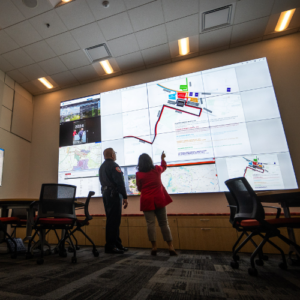About EHS
The NCSU Office of Environmental Health and Safety (EHS) provides leadership, support, information, training, and consultation of environmental, health, and safety practices. The EHS staff works in a coordinated effort to address health and safety issues in several areas, including:
Biological Safety
The Biological Safety department is dedicated to ensuring a safe and compliant research environment for faculty, staff, and students working with biological materials. This team provides guidance, training, and oversight to minimize risks associated with laboratory research.
Environmental Affairs
The Environmental Affairs Group has responsibility for oversight of environmental compliance programs such as Stormwater Management, Spill Prevention, Control, and Countermeasures, and Environmental Assessments.
Laboratory Safety
The academic laboratory environment is highly complex and requires support and guidance information to promote safe work practices and compliance. Our laboratory resources include: equipment resources, checklists, PPE guidance, and more.
Occupational Health
Occupational Health is working toward the goal of adequate program surveillance measures for a variety of exposure areas, early recognition of health alterations due to exposure and the management of occupational exposure programs.
Occupational Safety
Occupational Safety programs address physical work in NC State facilities that requires the interaction of human-machine-environment. Physical safety programs serve to mitigate risk and exposure to unsafe practices and reduce injury.
Radiation Safety
Radiation Safety staff provides training, conducts routine safety inspection, maintains radiation emergency response capabilities, and assists researchers with the acquisition and disposal of radioactive materials.
Our Mission
We support and advance the teaching, learning and research activities at NCSU by promoting a safe and healthy campus environment. We provide and coordinate programs, training courses, and other services that minimize safety risks. The presence of EHS can be felt throughout the campus. Below are a few examples of common EHS activities.
- In science laboratories: we evaluate and control, radioactive materials, and other agents which are potentially hazardous. We also provide training and education in safe laboratory practices.
- In University offices and classrooms: we investigate ergonomic issues, indoor air quality, and other sources of complaint. We also provide training and education for all staff and faculty in regards to safe office procedures.
- For University maintenance/construction: we evaluate and control programs for toxic materials including pesticides, paints, cleaners, and train staff on safe work procedures with support from University Facilities.
- For new University buildings and renovations: we evaluate for compliance with building and safety regulations, and for designs consistent with current industry practices.
- On University Safety Committees: we work with standing and unit safety committees to facilitate regulatory compliance, best practice development and practical measures to ensure health and safety standards.



